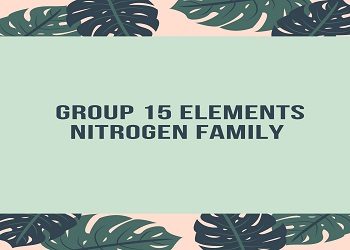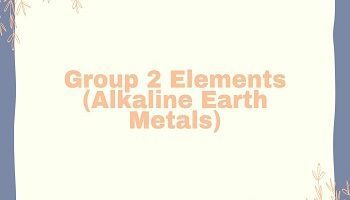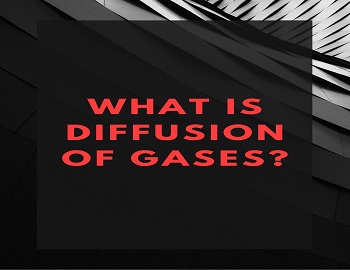Nitrogen Family:
The elements Nitrogen (N), Phosphorus (P), Arsenic (As), Antimony (Sb) and Bismuth (Bi) together constitute group 15 of the long form of Periodic table and are collectively known as members of nitrogen family.
General Trends in Physical Properties of Nitrogen Family:
(i) Electronic Configuration- The general outer electronic configuration of group 15 elements in ns2 np3 (n = 2 to 6) which shows that these elements have 5 electrons in the valence shell, two in s-orbital and three in p-orbital.
| Element / Symbol | Atomic Number | Electronic Configuration |
|---|---|---|
| Nitrogen, N | 7 | 1s2, 2s2 2p3 or [He] 2s2 2p3 |
| Phosphorous, P | 15 | 1s2, 2s2 2p6, 3s2 3p3 or [Ne] 3s2 3p3 |
| Arsenic, As | 33 | 1s2, 2s2 2p6, 3s2 3p6 3d10, 4s2 4p3 or [Ar] 3d10, 4s2 4p3 |
| Antimony, Sb | 51 | 1s2, 2s2 2p6, 3s2 3p6 3d10, 4s2 4p6 4d10, 5s2 5p3 or [ Kr] 4d10, 5s2 5p3 |
| Bismuth, Bi | 83 | 1s2, 2s2 2p6, 3s2 3p6 3d10, 4s2 4p6 4d10 4f14, 5s2 5p6 5d10, 6s2 6p3 or [Xe] 4f14, 5d10, 6s2 6p3 |
(ii) Density- On moving down the group from N to Bi, there is a regular increase in density with the increase in atomic number.
(iii) Atomic radii and Ionic radii- The atomic radii of group 15 elements are smaller than corresponding elements of group 14 due to their greater nuclear charge. However, on moving down the group from N to Bi, atomic radii show an increasing trend due to an increase in screening effect which overcomes the effect of increased nuclear charge. Like atomic radii, ionic radii of group 15 elements also shows an increasing trend on moving down the group.
(iv) Melting points and Boiling points- The melting points do not show regular trend on moving down the group from N to Bi. There is an increase in melting points from N to As and then decrease from As to Bi.
(v) Electronegativity- On moving down the group from N to Bi, there is a gradual decrease in electronegativity with the increase in atomic number. However, it remains the same from Sb to Bi.
(vi) Ionisation energy- Because of small atomic size and high nuclear charge than group 14 elements, the ionisation energy of group 15 elements are comparatively higher than the group 14 elements. However, on moving down the group from N to Bi, the ionisation energy goes on decreasing due to increase in atomic size leading to a decrease in the forces of attraction between the nucleus and valence electrons.
(vii) Electropositive Character ( or Metallic Character)- The elements of group 15 are less electropositive than group 14 elements because of their high ionisation energy. Electropositive (or metallic) character increases on moving down the group 15 due to decrease in ionisation energy. Example- N and P are distinctly non-metals, As and Sb are metalloids while Bi is true metal.
(viii) Oxidation States- The elements of group 15 show two types of oxidation states-
- Positive Oxidation States- The outer electronic configuration of group 15 elements is ns2 np3 which shows that these elements exhibit oxidation states of +3 (using only three p-electrons in bonding) and + 5 (involving all the 5 valence electrons in bonding). On moving down the group, the tendency to show +5 oxidation state decreases and that of +3 oxidation state increases, because with the increase in atomic mass, the s-electrons become inert due to inert pair effect and only p-electrons are involved in bonding. Example- Bi shows only +3 oxidation state while oxidation state of N and P in N2O5 and P2O5 is +5.
- Negative Oxidation States- These elements require three electrons to acquire the stable noble gas configuration. Nitrogen because of its small size and high electronegativity can accept electrons to form Nitrides (N3-). Example- Mg3N2, Ca3N2 etc. thereby showing an oxidation state of -3. It also shows the -3 oxidation state in NH3 (forming covalent bonds). The tendency to show -3 oxidation state decreases on moving down the group due to a decrease in electronegativity. Phosphorous shows -3 oxidation state in PH3 and Phosphides (P3-) but to a lesser extent. The other elements of the group form covalent compounds with more electropositive elements thereby showing an oxidation state of -3. Example- sodium arsenide (Na3As), zinc antimonide (Zn3Sb2) and magnesium bismuthide (Mg3Bi2).
(ix) Catenation- The elements of group 15 show the property of catenation but to a much less extent than group 14 elements. It further goes on decreasing on moving down the group with the rise in atomic number. Example- N- can form chain extending up to three N-atoms (e.g. Azide in N3–) while in other members of the family, these chains are limited only up to two atoms. Example- diphosphine (P2H4).









Comments (No)